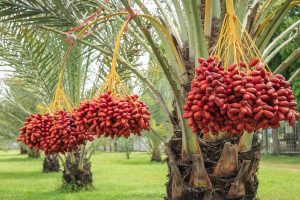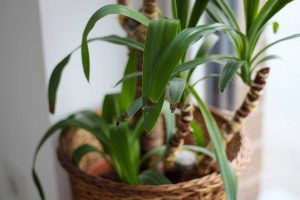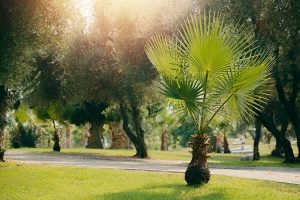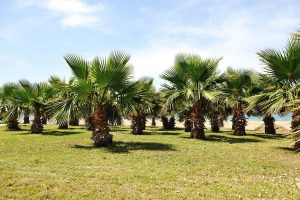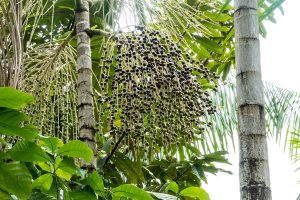Palm trees are evergreen, flowering plants which all belong to the Arecaceae family. This family is widely known as the Palm family since it comprises over 2500 different species of palms.
Palms are considered to be a tropical type of tree, however, they grow in a diverse range of habitats, from rainforests to beaches, and deserts.
Table of Contents
Paurotis Palm
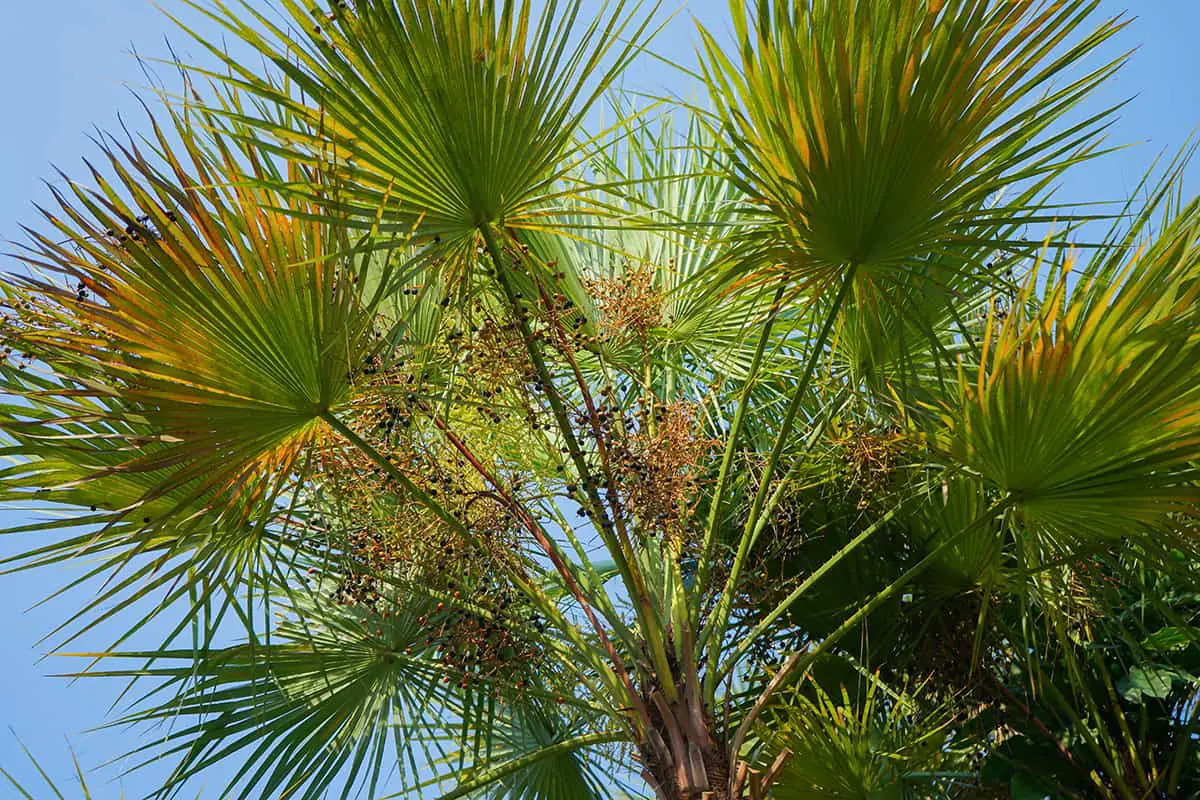
- Botanical name: Acoelorrhaphe wrightii
- Common names: Paurotis Palm, Everglades Palm, Madeira Palm
- Plant family: Arecaceae
- USDA hardiness zone: 10 – 11
- Mature height: 30 feet
- Mature spread: 25 feet
This attractive palm is native to Central America, the Bahamas, the Caribbean, and the southern tip of Florida in the United States. It is often known as the Everglades Palm because it is native to this region and grows in dense clumps there, amongst swamp land and waterways.
Visually the tree has a long and slender trunk, though it is usually multi-stemmed and can spread easily to form colonies. The foliage is fan-shaped, with each leaf spanning around 2 feet across at maturity.
The leaves can cloak the tree from the ground up to the extent that the trunks can sometimes be completely hidden from view, but these leaves can be trimmed back if you want to give the tree a more traditional palm-look.
As a native of wet habitats, the Paurotis Palm is an excellent choice for growing alongside streams or in garden ponds to add some lush foliage and a tropical aesthetic.
They grow easily in warm, sunny climates, and can tolerate partial sun but growth will be reduced. These trees can adapt to drier soils and can tolerate low levels of saltwater and coastal winds.
Bismarck Palm
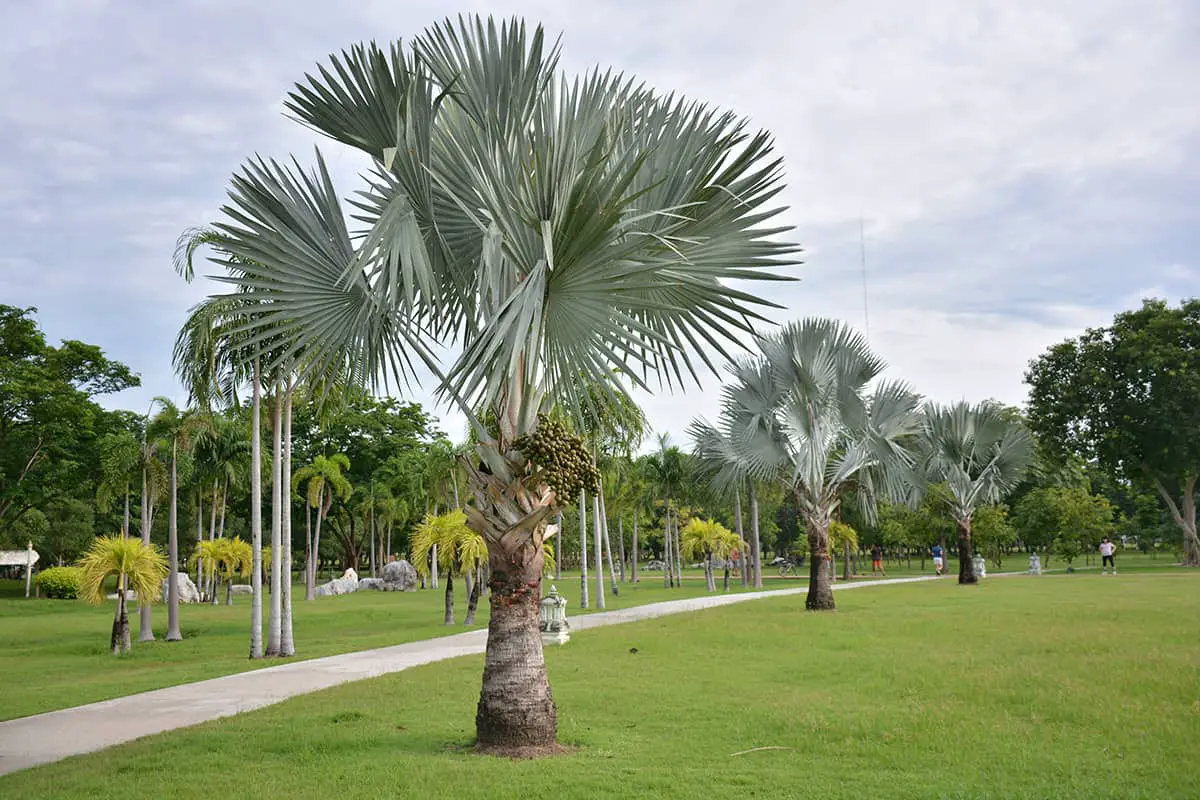
- Botanical name: Bismarckia nobilis
- Common names: Bismarck Palm
- Plant family: Arecaceae
- USDA hardiness zone: 10 – 11
- Mature height: 50 to 80 feet
- Mature spread: 15 feet
Bismarck Palm trees are native to Madagascar, which is an island rich in diverse species of palm trees. Bismarck Palms fare well in other subtropical and tropical climates, and they are known to grow in Florida, Texas, Arizona, Indonesia, and some parts of Australia.
The foliage of this tree is incredibly striking, with individual leaves that are stiff, fan-shaped, spreading up to 4 feet wide. The leaves have a pale gray-blue color that can look silver in some lights. The leaves are held at the top of a single, thick trunk, which is also gray in color.
The Bismarck Palm will grow at a fairly slow rate when young, but this typically speeds up as the tree matures. Once the trunk develops, it can begin to grow at an impressive rate.
It performs best in full to partial sun and should be grown in well-draining soil because it is susceptible to root rot. Bismarck Palms show excellent tolerance to drought, but they do struggle with damage in strong winds.
Guadalupe Palm
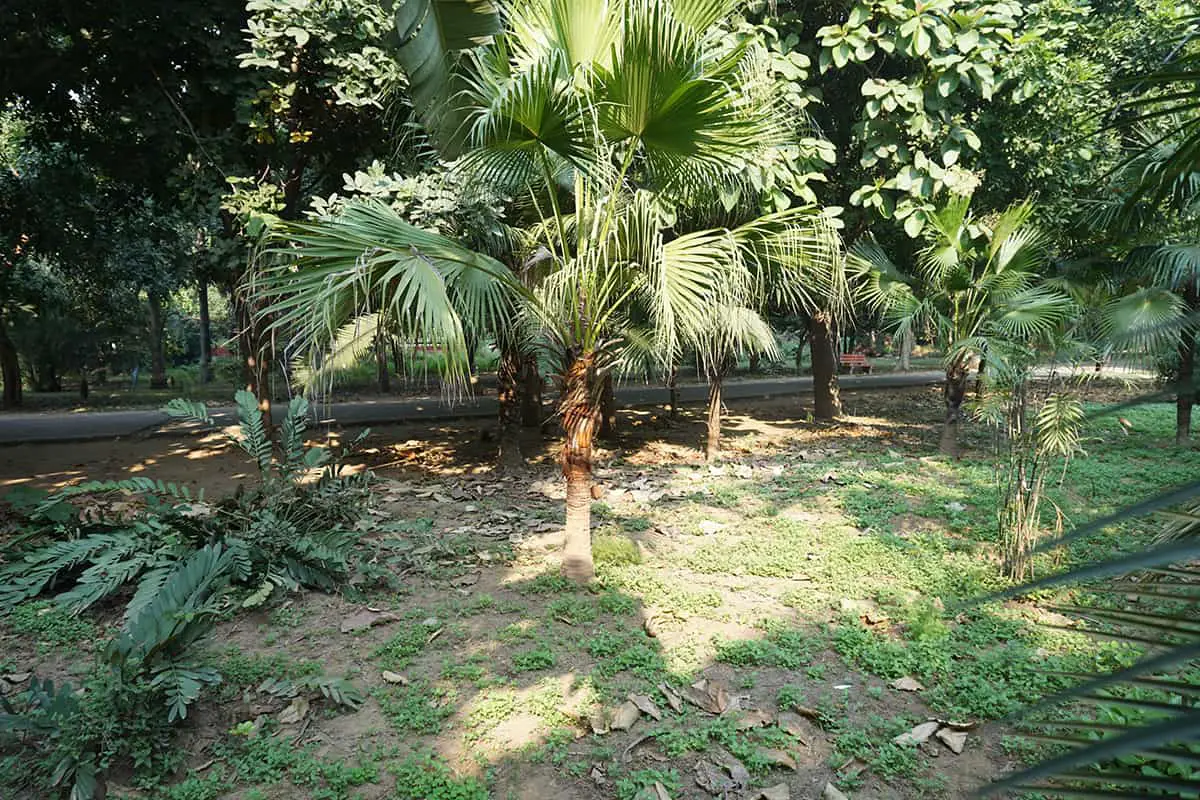
- Botanical name: Brahea edulis
- Common names: Guadalupe Palm
- Plant family: Arecaceae
- USDA hardiness zone: 9 – 11
- Mature height: 15 to 40 feet
- Mature spread: 10 – 15 feet
This palm is endemic to Guadalupe Island, which is a volcanic island around 250 km off the coast of Mexico. It is a small to medium-sized palm, which produces a thick, stout trunk and a canopy of lush green, fan-shaped fronds.
Guadalupe Palm trees are known for the clusters of black fruits they produce, which follow drooping stems of pretty, cream-colored flowers. The fruits are sweet and fleshy, and they can be consumed raw or used in cooking to make jams and jellies.
The Guadalupe Palm has a slow-growing habit, gaining around 1 foot in height per year until it reaches its ultimate size of between 15 and 40 feet. It adapts well to poor soils and drought but will perform best in well-draining soil which is supplemented with some water through dry summer months. This is a palm that will not thrive in humid conditions and prefers drier habitats.
European Fan Palm

- Botanical name: Chamaerops humilis
- Common names: European Fan Palm, Dwarf Fan Palm, Mediterranean Dwarf Palm
- Plant family: Arecaceae
- USDA hardiness zone: 9 – 11
- Mature height: 15 feet
- Mature spread: 20 feet
The European Fan Palm produces suckers, which, if allowed to grow, will result in a multi-stemmed tree. However, it is easy to grow this palm as a single-trunked tree by simply removing the suckers as they appear.
The tree can grow wider than it grows tall, giving an overall rounded shape to the tree. It produces fan-shaped leaves which are held at the end of long, spiky petioles spanning around 4 feet in length. The fans themselves range in size from 1 to 2 feet wide and are each broken up into 10 to 20 individual narrow green sections, held stiffly in place.
The European Fan Palm is native to the Mediterranean region and is the only palm that grows natively anywhere in Europe, withstanding temperatures down to 10 °F.
European Fan Palms grow best in full sun, but they can tolerate shade. They prefer well-draining, fertile soils which are given supplemental water through summer. However, they will adapt to dry and poor soils once well-established.
Florida Silver Palm
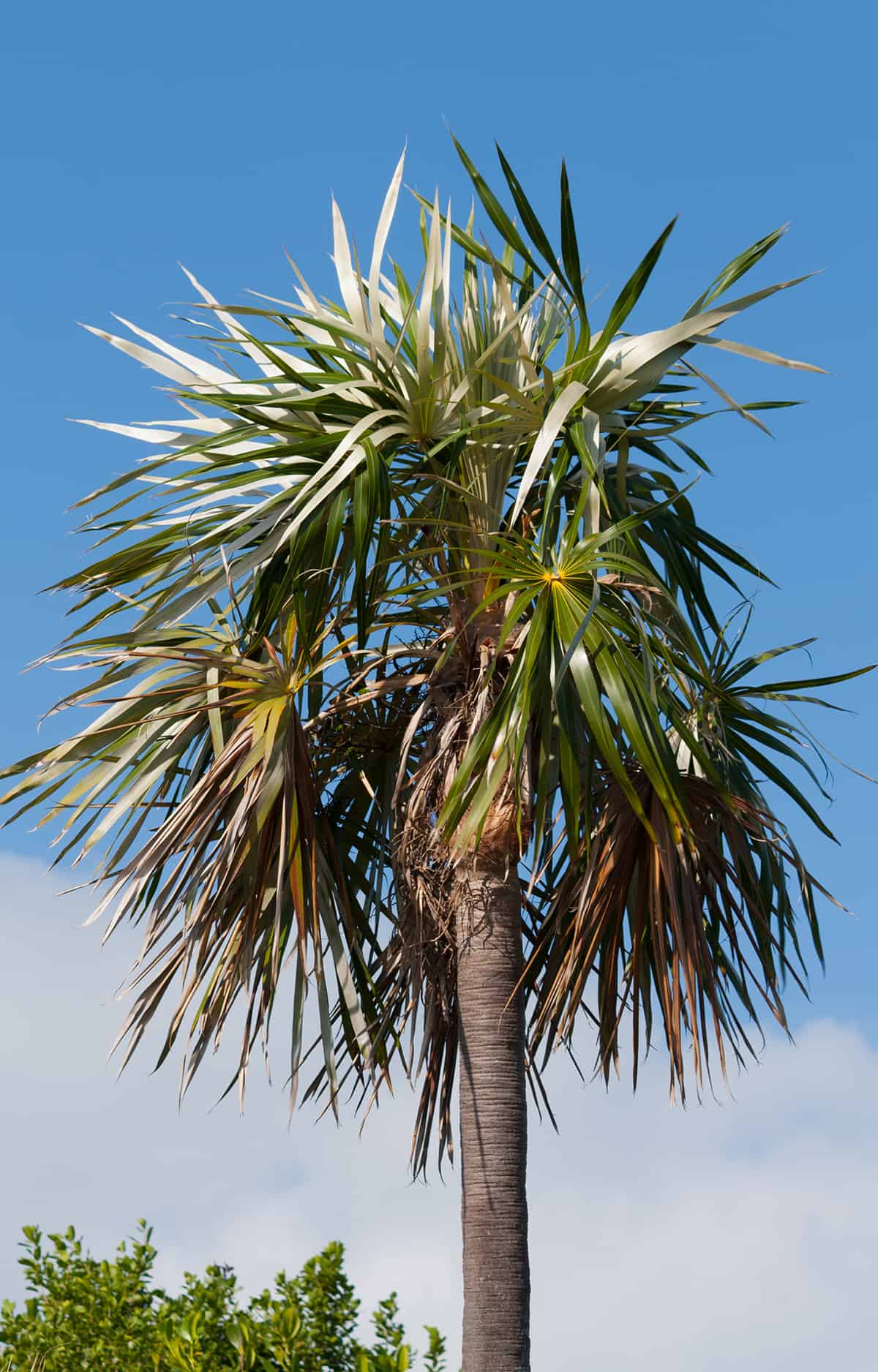
- Botanical name: Coccothrinax argentata
- Common names: Florida Silver Palm
- Plant family: Arecaceae
- USDA hardiness zone: 10 – 11
- Mature height: 20 feet
- Mature spread: 5 feet
The Florida Silver Palm is named after one of its native habitats, Florida, and the fact that its green fronds have silver undersides. The tree is also native to predominantly dry and rocky areas of Mexico, Colombia, the Bahamas, and the West Indies.
It has a smooth and lean trunk which is topped by a profusion of large, fan-shaped fronds. Each fan typically measures around 2 feet across, and these are held tightly in clusters to give a rounded shape to the canopy.
The tree also produces white flowers which appear at the end of long stalks in the summer and give way to purple-black fruits by fall, which are popular amongst local wildlife such as birds.
This is a slow-growing palm, gaining less than 6 inches each year, making it well suited to container growing. It does well in coastal regions since it is very tolerant of high winds and salt spray, though should not be grown in saltwater.
The Florida Silver Palm enjoys well-draining soils which can range from dry to moist, and it is exceptionally tolerant of drought once established.
Lipstick Palm
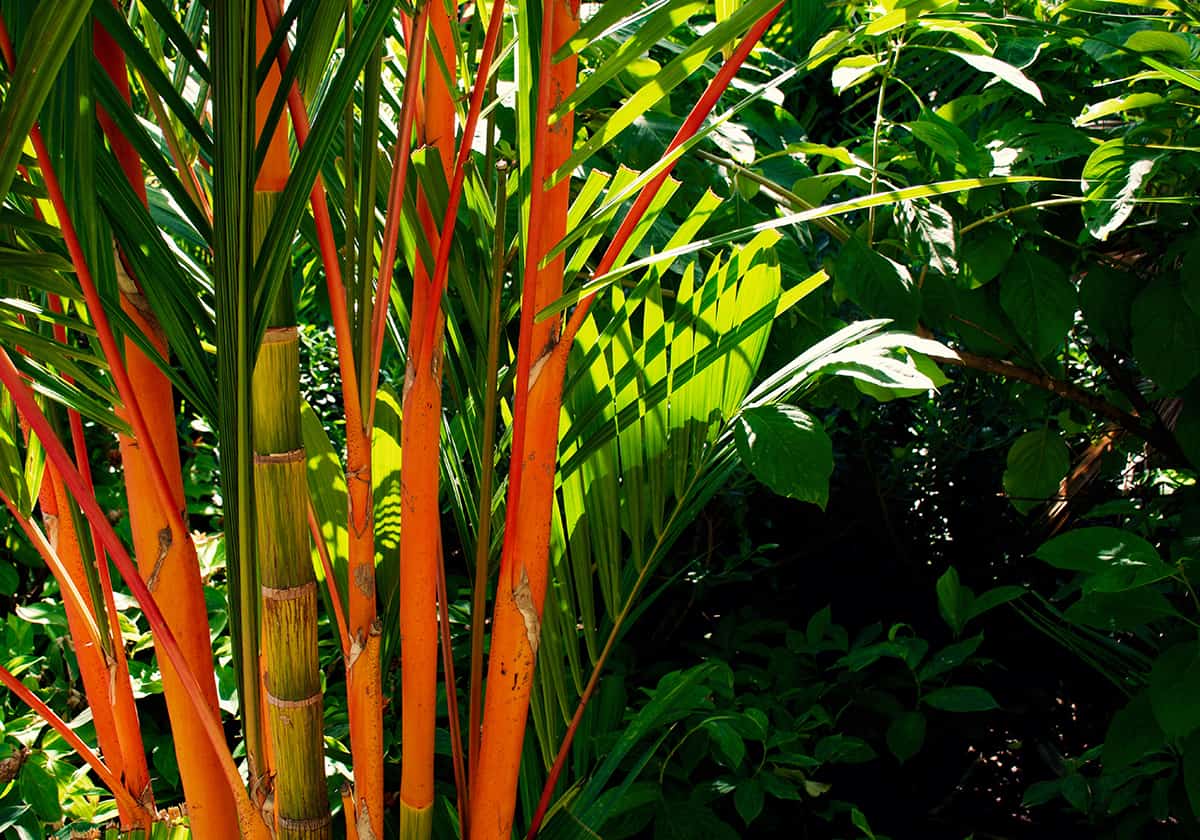
- Botanical name: Cyrtostachys renda
- Common names: Lipstick Palm, Red Sealing Wax Palm, Red Candle Wax Palm
- Plant family: Arecaceae
- USDA hardiness zone: 11 – 12
- Mature height: 35 feet
- Mature spread: 20 feet
The Lipstick Palm is native to parts of Southeast Asia, including Indonesia, Thailand, Malaysia, and Borneo. It is an easily recognizable palm due to its distinctive thin trunk which is bright lime green at the base and vivid red towards the upper half.
The beaming scarlet color of the trunk contrasts heavily with the bright green color of the foliage. The foliage itself emerges in pinnate fronds which can span as much as 5 feet long. Lipstick
Palms grow slowly, and they can be quite particular about their conditions, which can make them troublesome to care for. However, they are an incredibly striking type of palm which make for an excellent focal point in a landscape.
Lipstick Palms are not tolerant of low temperatures, but they also do not do well in very hot climates. They require high humidity to thrive and moist, well-draining soils. Periods of drought are not tolerated by this tree, and they also do not fare well in high winds or areas where salt levels are high.
Triangle Palm
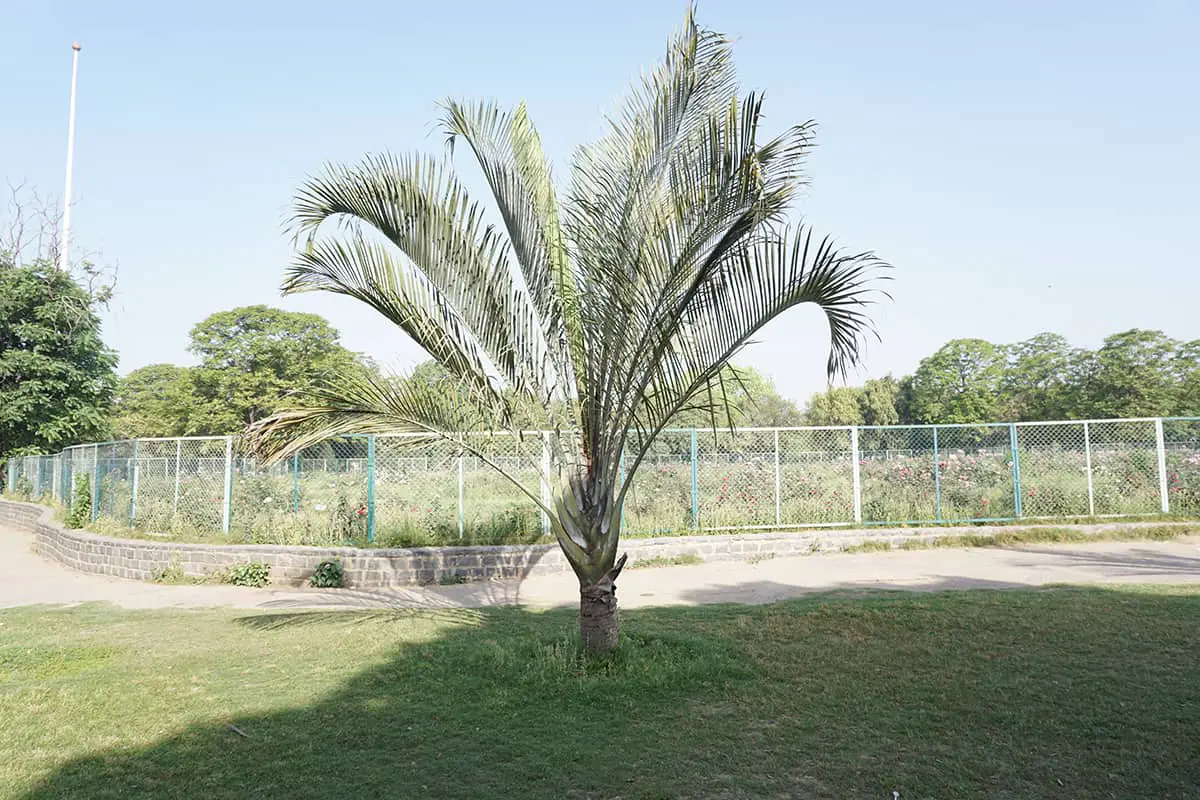
- Botanical name: Dypsis decaryi
- Common names: Triangle Palm
- Plant family: Arecaceae
- USDA hardiness zone: 10 – 13
- Mature height: 30 to 50 feet
- Mature spread: 50 feet
The Triangle Palm is a true statement tree, with feathered fronds held in upright, horizontal angles spanning as much as 10 feet in length. The tree is endemic to the rainforests of Madagascar, and in its native habitat, it is an endangered species, however, it has been widely cultivated outside of Madagascar and so is not at any risk of becoming extinct.
In its native environment, the tree grows to heights of around 50 feet. However, it is very unusual to grow to more than 30 feet outside of its natural range and instead forms a small to medium-sized tree.
The relatively small size and slow to medium growth rate make the tree well-suited for container growing. The foliage of the Triangle Palm is gray-green to blue-green in color, and small yellow flowers emerge in spring on long spikes.
Triangle Palms are exceptionally tolerant of extreme heat levels, being suitable for growing in USDA hardiness zones 10 to 13. These trees thrive in full sun and well-draining, moist soils; however, they can adapt to partial sun and are very tolerant of drought once established.
Chilean Wine Palm
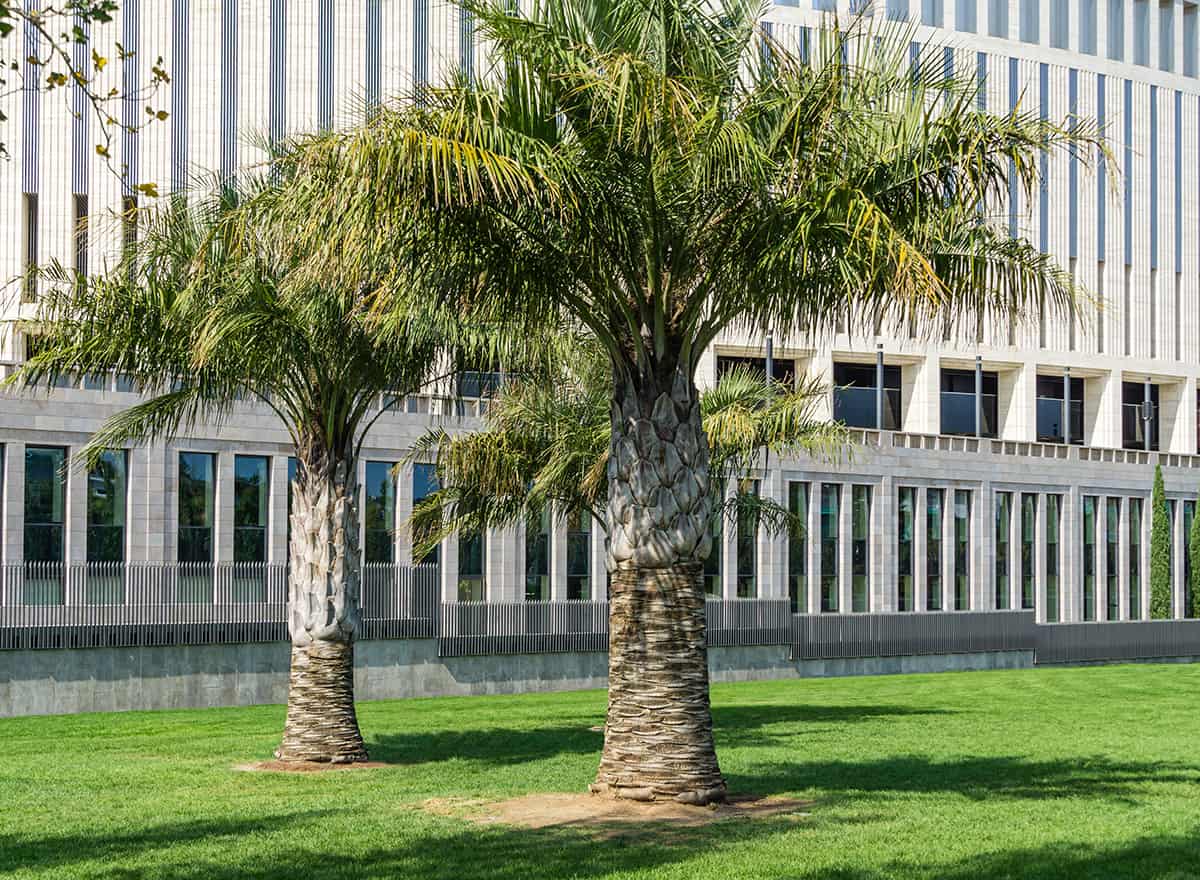
- Botanical name: Jubaea chilensis
- Common names: Chilean Wine Palm, Chile Coco Palm, Honey Palm, Palm Honey Tree
- Plant family: Arecaceae
- USDA hardiness zone: 8 – 11
- Mature height: 80 feet
- Mature spread: 25 feet
The Chilean Wine Palm is endemic to a small area of Chile and is named after the fact that its sweet sap is used for making palm wine. This is an unusual-looking palm, and as such has become something of a collector’s item amongst palm growers. It features a chunky single trunk which often has a swollen shape in the middle.
Of the approximately 2600 species of palms known in existence, the Chilean Wine Palm is believed to have the largest trunk width of all palms. It is considered to be a magnificent palm by many, though it was considered by Charles Darwin to be rather unpleasant looking. On his exploration of Chile, Darwin noted, “These palms are, for their family, ugly trees. Their trunk is very large, and of a curious form, being thicker in the middle than at the base or top.”
The Chilean Wine Palm is a long-lived tree, taking more than 50 years to reach its ultimate height and surviving for as many as 1500 years. It produces purple flowers and 4-foot-long flower stalks, and these give way to hard-shelled fruits in shades of orange and yellow.
The Chilean Wine Palm is known as the most cold-hardy of all feather palms, able to withstand temperatures down to 10 °F. It grows well in full sun and well-draining soils which are moist to dry. It grows surprisingly well as an indoor plant when kept in bright conditions.
Blue Latan Palm
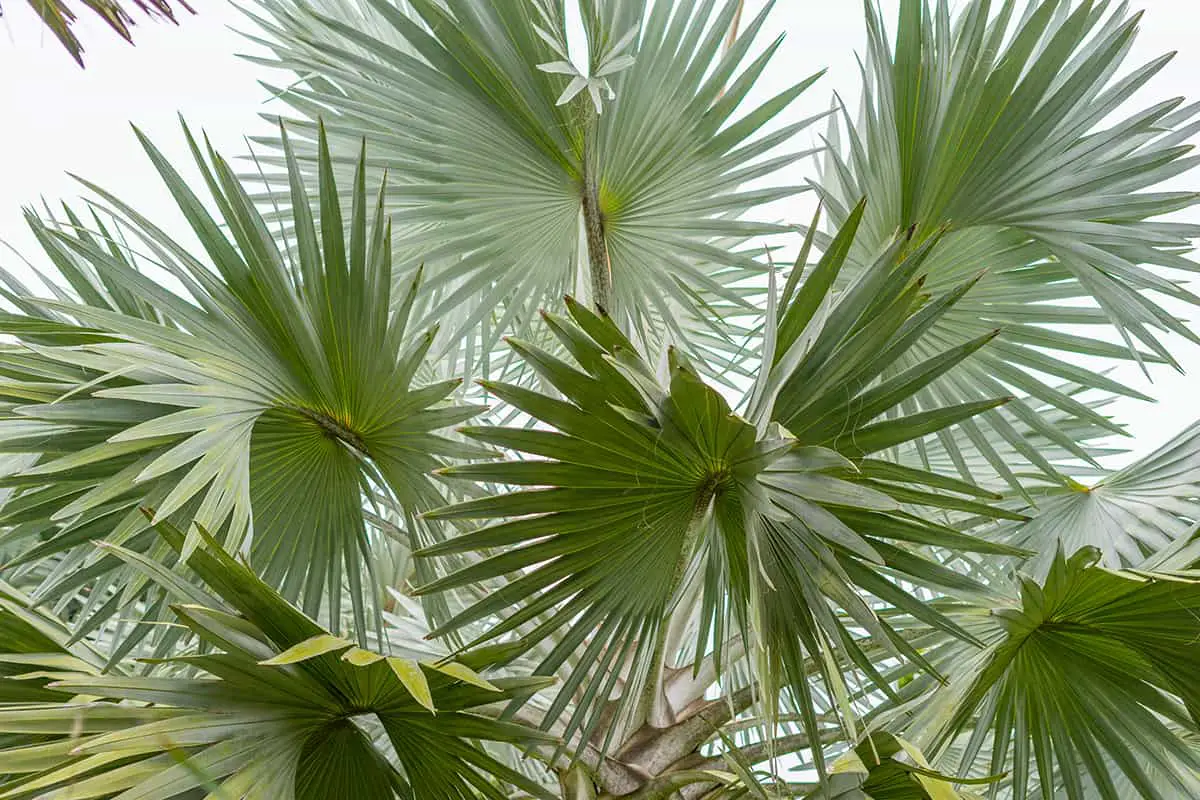
- Botanical name: Latania loddigesii
- Common names: Blue Latan Palm
- Plant family: Arecaceae
- USDA hardiness zone: 10 – 11
- Mature height: 25 feet
- Mature spread: 15 feet
This small palm tree is endemic to Mauritius, where it grows only on offshore islands. It produces a dense canopy of stiff, fan-shaped fronds in a blue-gray color.
The fronds have a slightly blue mottled effect, and can have margins in red or blue. Each fan can spread to a massive 8 feet wide, which is quite remarkable considering that the entire tree itself only typically reaches heights of 20 to 25 feet. The trunk of this tree is sturdy at around 10 inches in width, with a swollen base at ground level.
Blue Latan Palms are an easy type of palm to grow because they adapt well to a variety of growing conditions. They are quite a tough species, which can thrive in full sun or partial sun and moist or dry soils.
Once well established, the Blue Latan Palm can survive extended periods of drought without any issues. They are tolerant of high heat levels and will also withstand salty conditions, making them well-suited for growing in coastal regions.
Canary Island Date Palm
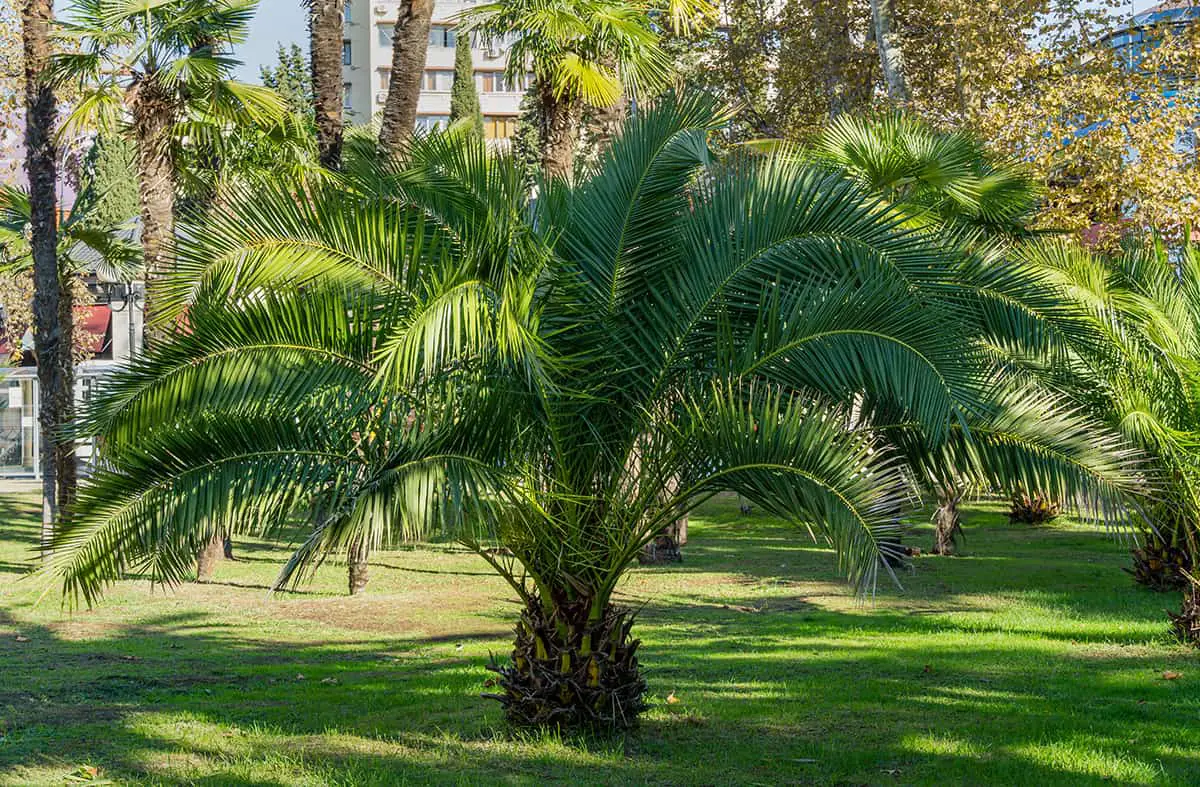
- Botanical name: Phoenix canariensis
- Common names: Canary Island Date Palm, Slender Date Palm, Pineapple Palm
- Plant family: Arecaceae
- USDA hardiness zone: 9 – 11
- Mature height: 60 feet
- Mature spread: 40 feet
This tree is the national symbol of the Canary Islands, where it grows natively. It is a close relative of the Date Palm (Phoenix dactylifera), from which edible date fruits are cultivated.
The Canary Island Date Palm also produces date fruits that are edible, though they are not considered to be as palatable as true dates from the Date Palm. The Canary Date Palm is slowly growing, and takes a majestic shape with an abundance of large, feathered fronds arching gently over at the top of a slender trunk.
Each frond can measure as much as 10 feet in length, and there will be as many as 100 individual fronds on a single tree, for a full and lush look. In spring, the Canary Date Palm produces drooping clusters of yellow flowers which hang in panicles between 3 and 4 feet long.
This is a medium to tall-sized tree which typically reaches around 60 feet in height, though it is an excellent choice of palm for container growing because it remains fairly compact when the roots are bound.
The Canary Date Palm is easy to grow and is widely cultivated in temperate areas across the world for its tropical appearance. It prefers full sun but will tolerate light shade and performs best in soils which are well-draining, fertile, and kept moderately moist. Once established, the Canary Date Palm can withstand periods of drought.
Needle Palm
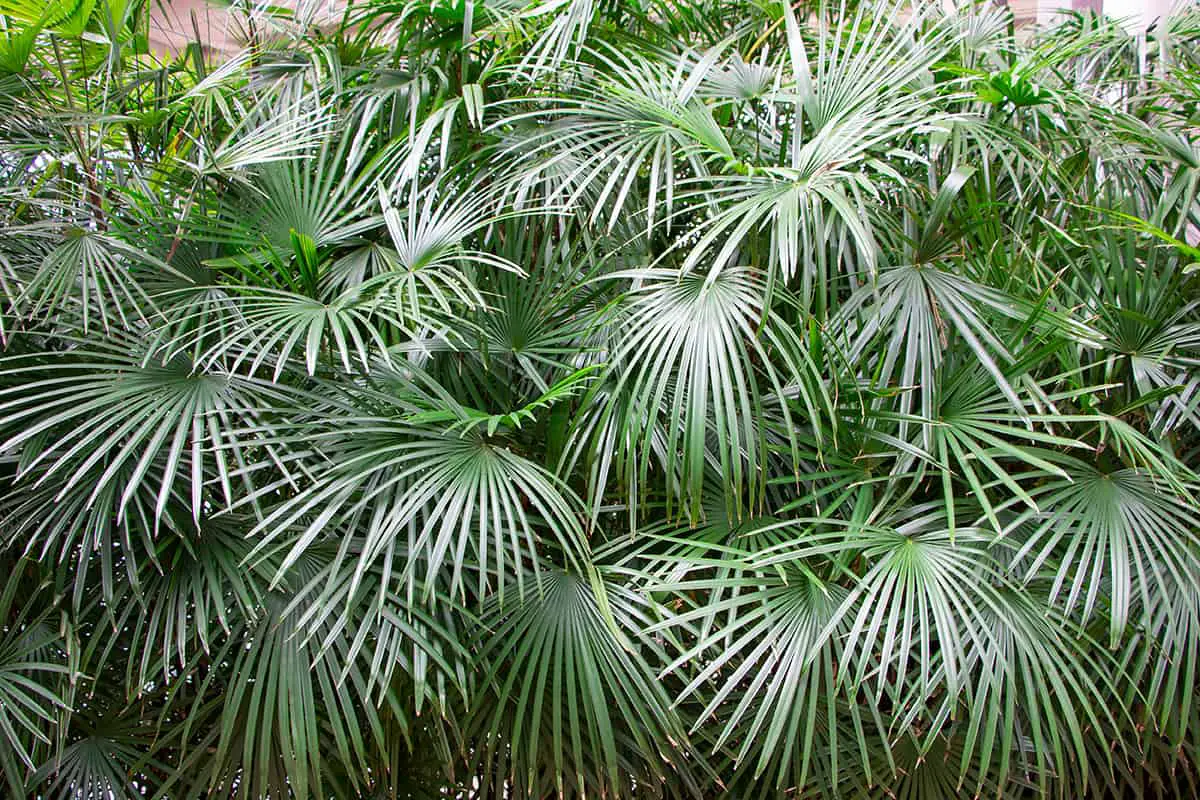
- Botanical name: Rhapidophyllum hystrix
- Common names: Needle Palm, Porcupine Palm
- Plant family: Arecaceae
- USDA hardiness zone: 6 – 10
- Mature height: 6 feet
- Mature spread: 8 feet
The Needle Palm is one of the most cold-hardy palms in existence, being suitable for growing in USDA zones as low as 6. It is native to coastal regions of the United States, including Florida, Mississippi, South Carolina, and Alabama.
The Needle Palm has a thick and short trunk that will be almost entirely covered by the large fronds to give it a look that more closely resembles a shrub than a tree. The palmate fronds are divided into slender segments and have a dark green color.
The leaf sheaths are clothed in sharp spines which come to needle-like points, hence the common names of Needle Palm or Porcupine Palm. The spines mean that wildlife is unable to access the inner parts of the tree, and it can lend itself well to use as prevention against intruders into the grounds.
The palm sends out suckers, so even after a heavy freeze that kills back all of the foliage and the trunk, new suckers will be sent out to produce a new tree.
The Needle Palm is easy to care for, preferring well-drained soils which are kept moist and have a good level of organic content. It can also adapt to wet soils and grows well around ponds or wetlands.
It performs well in full sun but can also thrive in partial shade, making it a good choice for planting beneath taller palms which will provide dappled shade. The Needle Palm is a good choice of palm for container growing. It can survive much lower temperatures than most palms but should be kept protected from heavy winds.
Lady Palm
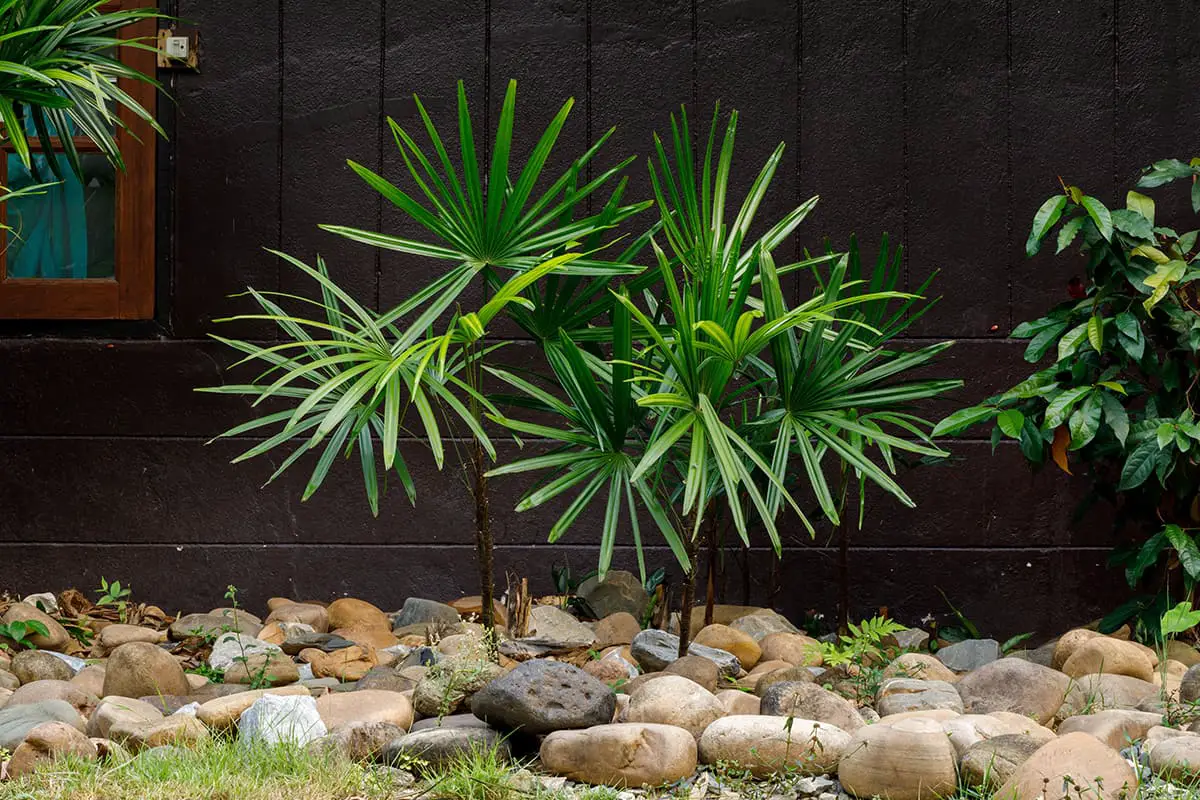
- Botanical name: Rhapis excelsa
- Common names: Lady Palm, Bamboo Palm, Broadleaf Lady Palm
- Plant family: Arecaceae
- USDA hardiness zone: 9 – 11
- Mature height: 15 feet
- Mature spread: 15 feet
The Lady Palm is not known in the wild, however it is believed to have been native to Vietnam and China. It is commonly grown as a houseplant, but can also be kept outside in USDA hardiness zones 9 to 11. The Lady Palm is also known as the Bamboo Palm because it produces foliage that closely resembles bamboo grass, however, the two plants are not related.
The leaves of the Lady Palm are like widely-spread fans, and each divided segment is broad and ribbed. The foliage clumps together at the top of a sturdy cane, which also adds to the bamboo-like effect. This is a small palm which rarely exceeds 15 feet in height and will spread via rhizomatous offshoots. It grows well in a container.
The Lady Palm, when kept outdoors, should be grown in partial shade beneath the cover of a loose canopy which allows for dapples of sunlight. It can also survive in heavy shade, though growth will be slower.
The soil a Lady Palm is grown in should be well draining. It can tolerate drought when well established, but if grown in sunny conditions will need the soil to be kept moist.
Chinese Windmill Palm
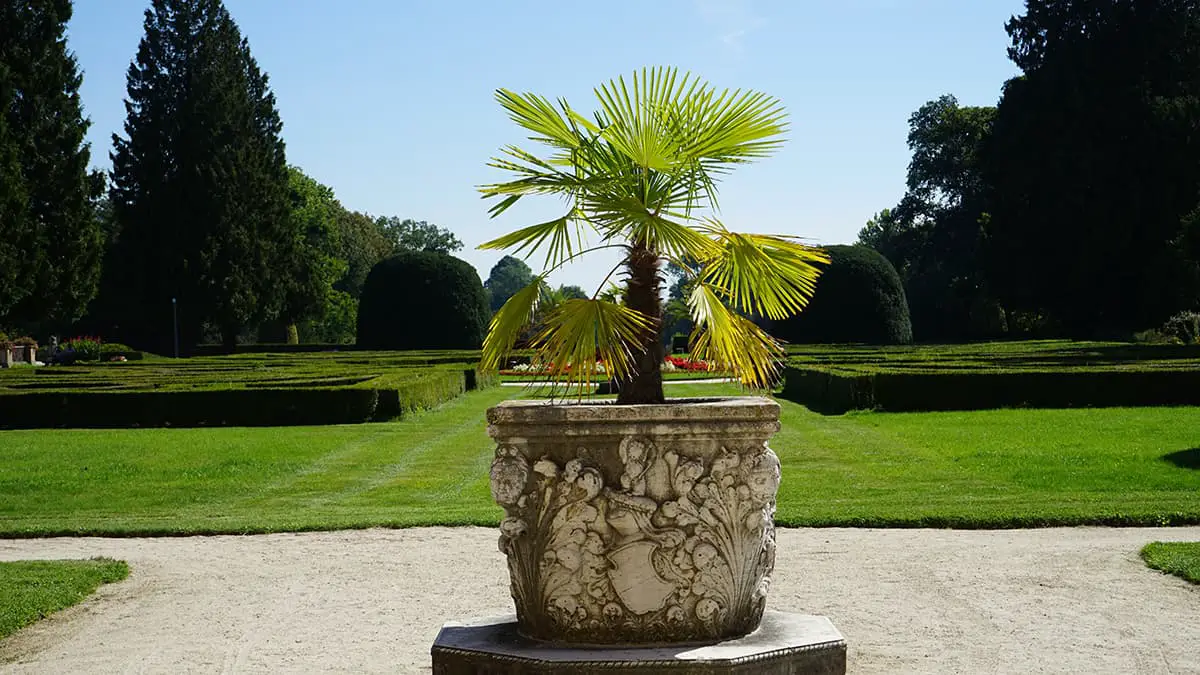
- Botanical name: Trachycarpus fortunei
- Common names: Chinese Windmill Palm, Windmill Palm, Hemp Palm, Chusan Palm
- Plant family: Arecaceae
- USDA hardiness zone: 7 – 11
- Mature height: 10 feet
- Mature spread: 6 feet
This is a type of fan palm which is native to China, India, Myanmar, and Japan. It is a visually striking palm with elegant foliage, an exceptionally rough and hairy trunk, and heavy clusters of bright yellow flowers which dangle from the tree in spring. The flowers give way to blue fruits which create further interest through fall.
The Chinese Windmill Palm grows very easily and will adapt to a variety of conditions. It grows in full sun to part shade and is tolerant of wind and salt. It can survive short periods of cold temperatures down to 5 °F, but the roots should be protected through winter with mulch.
Mexican Fan Palm

- Botanical name: Washingtonia robusta
- Common names: Mexican Fan Palm, Thread Palm, Sky Duster
- Plant family: Arecaceae
- USDA hardiness zone: 9 – 11
- Mature height: 80 feet
- Mature spread: 10 feet
This is a tall palm that typically reaches around 80 feet in height but has been known to exceed 100 feet. It is native to Mexico but has been naturalized across some of the south and west United States, as well as warmer areas of Europe, including Spain, Italy, and France. The tree has a slender trunk which is swollen at the base, and elegant, green, fan-shaped fronds.
This tree grows in full sun and well-draining soil.
Common Palm Tree FAQs
How Long Do Palm Trees Last?
Palm trees are famous for their resilience and ability to thrive in various environments. With more than 2,500 species growing worldwide, the lifespan of palm trees varies, depending on factors like species, location, and care.
Generally, smaller palm trees have a lifespan of 30 to 40 years, while bigger ones, such as the Date Palm Tree, can live for over a century. Some reports even claim that Date Palm Trees can live beyond 200 years. When considering all palms as a single group, the average life expectancy is approximately 70 years.
It’s essential to note that proper care and maintenance are crucial to ensuring a healthy life for these incredible plants. By providing optimal growing conditions, palm trees can grace landscapes with their beauty for many decades.
Which Fruits Grow on Palm Trees?
Palm trees produce various fruits, including coconuts, dates, acai berries, oil palm fruits, saw palmetto fruits, jelly palm fruits, and peach palm fruits. These fruits offer a diverse array of tastes and uses.
What Colors Can Be Seen on Palm Trees?
You can find a variety of palm tree colors that exhibit in fronds, trunks, fruits, and flowers.
Although palm tree fronds are typically green, they can also appear in shades of gray and blue. The trunk color varies by species, ranging from brown to gray. Palm flowers come in a wide range of colors, from white and yellow to pink, red, and green. The fruits are often darker shades of blue-black, deep purple, brown, and dark red but can also be brighter colors like orange.

